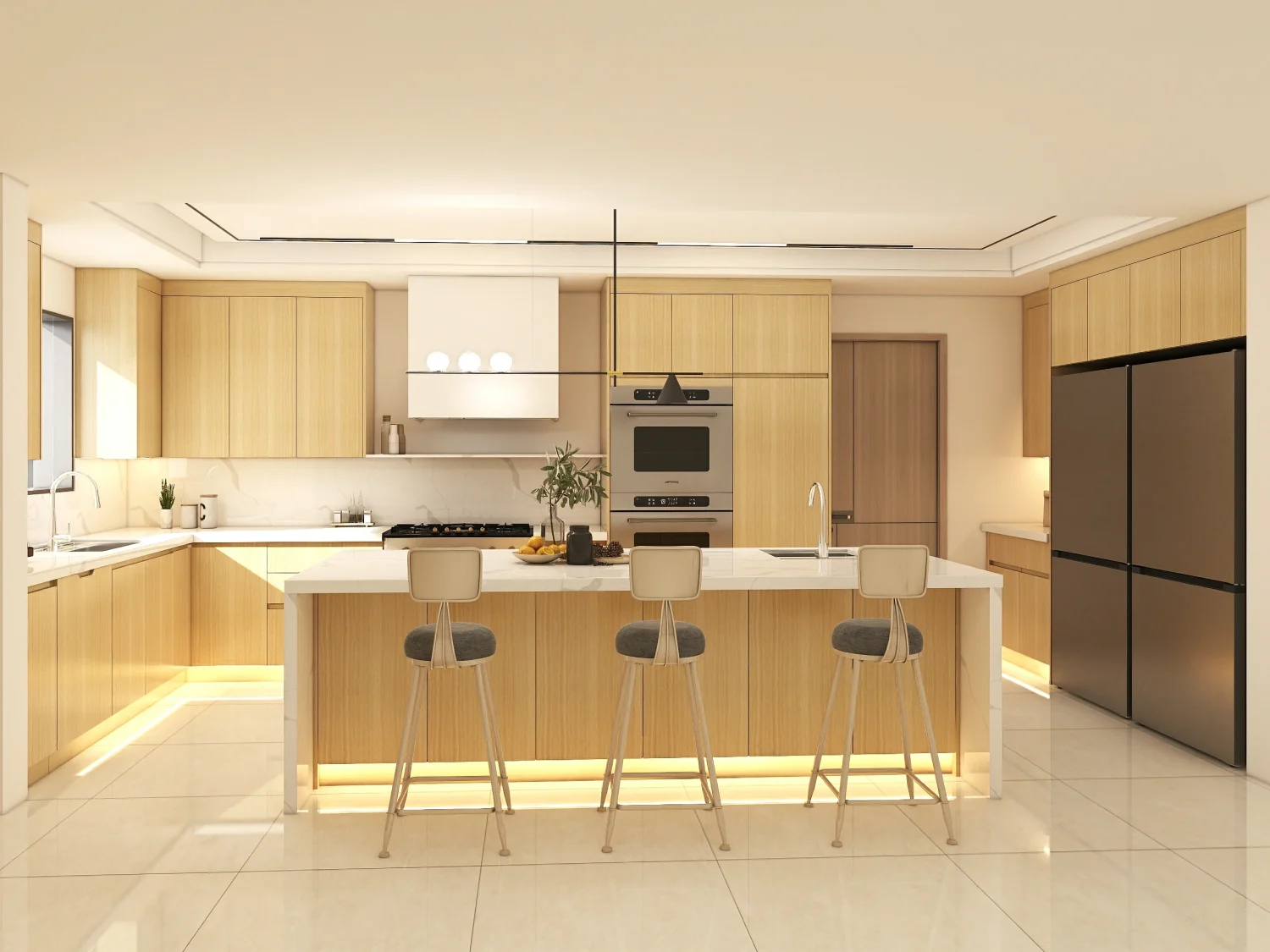Wood Veneer Cabinets: Craftsmanship, Design, Benefits, and Maintenance Tips
- PA Home
When it comes to designing a kitchen or living space, cabinets are often the centerpiece of both function and style. Among the many materials available, wood veneer cabinets offer a unique combination of beauty, affordability, and sustainability. If you’re considering them for your next project, you’re in the right place to learn everything you need to know.
In this guide, we’ll walk you through what wood veneer cabinets are, their advantages and disadvantages, how to maintain them, and why they may be the perfect choice for your home, especially if you’re looking for eco-friendly and stylish solutions.
What Are Wood Veneer Cabinets? Structure and Craftsmanship Explained

Wood veneer cabinets are a popular choice for many homeowners who want the luxurious look of solid wood without the high price tag. But what exactly are they? Wood veneer refers to a thin layer of real wood, typically about 1/32-inch thick, that is applied to a solid core like MDF (Medium-Density Fiberboard) or plywood.
How Are They Made?
- Base Material: The core of a wood veneer cabinet is usually made from engineered wood like MDF or plywood, which provides stability and strength.
- Veneer Layer: A thin slice of real wood is adhered to the core material. The veneer can be from various types of wood, such as oak, walnut, or cherry, depending on your design preference.
- Finishing Touch: The veneer is finished with a protective coating to ensure durability and enhance the natural beauty of the wood.
Wood veneer cabinets are generally more affordable than solid wood cabinets because the process uses less of the actual wood. This makes them a great option if you’re aiming for a wood aesthetic at a lower cost.
The Pros and Cons of Wood Veneer Cabinets
Pros
- Cost-Effective: One of the biggest advantages of wood veneer cabinets is their affordability. You get the look of solid wood without the hefty price tag, making them an ideal choice for those on a budget.
- Eco-Friendly: Since veneer uses a thin layer of real wood, it’s a more sustainable option than solid wood cabinets. Many veneer manufacturers use FSC-certified wood, ensuring responsible sourcing.
- Versatility: Wood veneer cabinets can be made in a variety of styles, colors, and finishes. Whether you’re going for a rustic or modern look, you’ll find plenty of options to fit your design vision.
- Stability: Unlike solid wood, which can warp or crack over time, wood veneer is more stable and less affected by changes in humidity and temperature.
Cons
- Durability: While wood veneer is stable, it can be more prone to damage than solid wood. It’s susceptible to peeling, scratching, and denting, especially on the edges of the veneer.
- Repairability: Repairing wood veneer can be tricky. Once the veneer is damaged, it’s challenging to fix, and it may require replacement.
- Not Fully “Solid Wood”: Despite having a real wood appearance, the core of a wood veneer cabinet is not solid wood. Some people may prefer the authenticity of full wood, especially for high-end projects.
Wood Veneer Cabinets Design and Style Selection
Wood veneer cabinets are incredibly versatile and can be customized to fit a range of design preferences. Here’s a breakdown of how to select the perfect style for your space.
Popular Wood Types for Veneer Cabinets
- Oak: Known for its classic look and durability, oak veneer is a great option for traditional or rustic kitchens.
- Walnut: If you’re aiming for a more luxurious and sophisticated look, walnut veneer is rich in color and texture.
- Maple: A light and subtle wood choice, maple veneer can create a clean and modern aesthetic.
- Cherry: With its reddish hue and elegant grain patterns, cherry veneer is ideal for those looking for warmth and beauty.
Finishes to Consider
- Matte vs. Gloss: A matte finish offers a soft, understated look, while a glossy finish can make the wood’s grain stand out and add a touch of modern sophistication.
- Stained or Painted: Staining the veneer enhances the natural beauty of the wood, while paint can give the cabinets a more contemporary, uniform appearance.
Wood veneer can be used in a variety of kitchen and bathroom cabinet designs, from sleek and modern to warm and traditional. Whether you want the rich, natural texture of oak or the elegant dark hues of walnut, there’s a veneer style that will complement any room.
Installation and Maintenance: Key Tips for Longevity
Wood veneer cabinets require some care and attention, but with the right maintenance, they can last for many years. Here’s how to install and maintain them properly.
Installation Tips
- Avoid Moisture: Wood veneer is more susceptible to water damage than solid wood. Ensure the cabinets are not exposed to excessive moisture, particularly in high-humidity areas like bathrooms.
- Proper Ventilation: Make sure your kitchen or bathroom is well-ventilated to prevent the wood from expanding or warping due to heat and humidity.
Maintenance Tips
- Cleaning: Use a soft cloth and mild detergent to clean the surface. Avoid harsh chemicals, as they can damage the finish.
- Polishing: Regularly polish your wood veneer cabinets with a wood-safe polish to maintain their shine and prevent dullness.
- Repairs: If your wood veneer gets scratched or damaged, try using a wood filler or touch-up marker to cover small blemishes. For larger repairs, professional help may be needed to replace the veneer layer.
By following these maintenance tips, you can keep your wood veneer cabinets looking fresh and beautiful for years to come.
Wood Veneer Cabinets vs. Other Materials: A Comparative Analysis
When choosing cabinets, it’s important to compare different materials. Here’s how wood veneer stacks up against other popular cabinet materials.
Wood Veneer vs. Solid Wood Cabinets
- Cost: Solid wood is significantly more expensive than wood veneer, making veneer a better choice for budget-conscious homeowners.
- Durability: While solid wood can last a lifetime, wood veneer is more prone to wear and tear. However, veneer is still a durable option if treated properly.
Wood Veneer vs. Laminate Cabinets
- Appearance: Wood veneer offers a more natural and authentic look than laminate cabinet, which can sometimes look artificial.
- Feel: Veneer provides a texture and depth that laminate cannot match, giving your cabinets a more high-end feel.
Wood Veneer vs. Thermofoil Cabinets
- Durability: Thermofoil is highly resistant to moisture and can be easier to maintain. However, it lacks the natural aesthetic and warmth of wood veneer.
- Environmental Impact: Thermofoil is made from plastic, whereas wood veneer is a more eco-friendly option when sourced responsibly.
| Property | Wood Veneer Cabinets | Solid Wood Cabinets | Laminate Cabinets |
|---|---|---|---|
| Appearance | High-end texture, fine grain | Unique design, natural beauty | Various styles, realistic wood-like look |
| Durability | Medium | High | Medium |
| Repairability | Difficult to repair | Easy to repair | Difficult to repair |
| Environmental | Better | Good | Generally lower |
| Price | Moderate | High | Low |
Environmental and Sustainability Considerations
Wood veneer cabinets are often a more eco-friendly choice compared to solid wood. Here’s why:
Sustainable Sourcing
Many wood veneer manufacturers use FSC-certified wood, ensuring that the wood used comes from responsibly managed forests. This helps reduce deforestation and promotes sustainable practices.
Reduced Waste
Since only a thin layer of real wood is used, wood veneer cabinets help conserve wood resources. Additionally, because the veneer is applied to an engineered wood core, less material is wasted during the manufacturing process compared to solid wood cabinets.
End of Life Considerations
Wood veneer cabinets are easier to recycle than solid wood because they use less wood and are often made with materials that can be repurposed at the end of their life cycle.
Conclusion
Wood veneer cabinets are an excellent choice for those looking to balance style, affordability, and sustainability. With the right maintenance and installation techniques, they can enhance your home for years. Whether you’re remodeling your kitchen or designing a brand-new space, wood veneer cabinets offer a perfect solution for any aesthetic.
If you’re ready to explore custom wood veneer cabinetry options that align with your vision and values, PA Home is here to help. Contact us today to get started on your next home improvement project.



